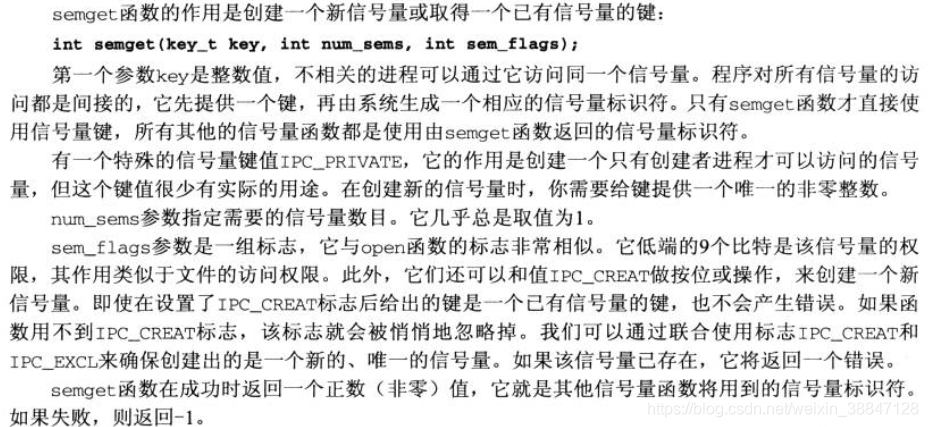linux系統——IPC程序通訊之訊號量
阿新 • • 發佈:2019-02-17
一、訊號量引出
當我們編寫的程式使用執行緒的時候,總是有一部分臨街程式碼,需要確保只有一個程序(或一個執行緒)可以進入這個臨街程式碼並擁有對資源的獨佔式訪問
——》檔案鎖,提供了一個原子化的檔案建立方法,它允許一個程序通過一個令牌(新建立的檔案)來取得成功,這個方法比較適合於處理簡單的問題

二、訊號量定義


三、訊號量函式
1、建立一個新的訊號量或取得一個已有的訊號量

2、改變訊號量的值

3、控制訊號量

4、訊號量例子
$:./sem1 & ./sem1 1
同時執行兩個程序,搶佔操作op_char 資源,輸出的OX應是均勻的
/* After the #includes, the function prototypes and the global variable, we come to the main function. There the semaphore is created with a call to semget, which returns the semaphore ID. If the program is the first to be called (i.e. it's called with a parameter and argc > 1), a call is made to set_semvalue to initialize the semaphore and op_char is set to X. */ #include <unistd.h> #include <stdlib.h> #include <stdio.h> #include <sys/sem.h> #if defined(__GNU_LIBRARY__) && !defined(_SEM_SEMUN_UNDEFINED) /* union semun is defined by including <sys/sem.h> */ #else /* according to X/OPEN we have to define it ourselves 操作結構體*/ union semun { int val; /* value for SETVAL */ struct semid_ds *buf; /* buffer for IPC_STAT, IPC_SET */ unsigned short int *array; /* array for GETALL, SETALL */ struct seminfo *__buf; /* buffer for IPC_INFO */ }; #endif static int set_semvalue(void); static void del_semvalue(void); static int semaphore_p(void); static int semaphore_v(void); static int sem_id; int main(int argc, char *argv[]) { int i; int pause_time; char op_char = 'O'; srand((unsigned int)getpid());//根據PID生成隨機數 sem_id = semget((key_t)1234, 1, 0666 | IPC_CREAT);//初始化訊號量,IPC_CREAT標誌作用是訊號量不存在的時候建立,存在的時候也不會報錯 if (argc > 1) { if (!set_semvalue()) { fprintf(stderr, "Failed to initialize semaphore\n"); exit(EXIT_FAILURE); } op_char = 'X'; sleep(2); } /* Then we have a loop which enters and leaves the critical section ten times. There, we first make a call to semaphore_p which sets the semaphore to wait, as this program is about to enter the critical section. */ for(i = 0; i < 10; i++) { if (!semaphore_p()) exit(EXIT_FAILURE); printf("%c", op_char); fflush(stdout);//清空標準輸出的快取 pause_time = rand() % 3; sleep(pause_time);//等待隨機時間 printf("%c", op_char); fflush(stdout); /* After the critical section, we call semaphore_v, setting the semaphore available, before going through the for loop again after a random wait. After the loop, the call to del_semvalue is made to clean up the code. */ if (!semaphore_v()) exit(EXIT_FAILURE); pause_time = rand() % 2; sleep(pause_time); } printf("\n%d - finished\n", getpid()); if (argc > 1) { sleep(10); del_semvalue(); } exit(EXIT_SUCCESS); } /* The function set_semvalue initializes the semaphore using the SETVAL command in a semctl call. We need to do this before we can use the semaphore. */ static int set_semvalue(void) { union semun sem_union; sem_union.val = 1; if (semctl(sem_id, 0, SETVAL, sem_union) == -1) return(0);//規範訊號量的動作,SETVAL用來把訊號量設定為一個已知的值 return(1); } /* The del_semvalue function has almost the same form, except the call to semctl uses the command IPC_RMID to remove the semaphore's ID. */ static void del_semvalue(void) { union semun sem_union; if (semctl(sem_id, 0, IPC_RMID, sem_union) == -1) fprintf(stderr, "Failed to delete semaphore\n"); } /* semaphore_p changes the semaphore by -1 (waiting). */ static int semaphore_p(void) { struct sembuf sem_b; sem_b.sem_num = 0; sem_b.sem_op = -1; /* P() */ sem_b.sem_flg = SEM_UNDO; if (semop(sem_id, &sem_b, 1) == -1) { fprintf(stderr, "semaphore_p failed\n"); return(0); } return(1); } /* semaphore_v is similar except for setting the sem_op part of the sembuf structure to 1, so that the semaphore becomes available. */ static int semaphore_v(void) { struct sembuf sem_b; sem_b.sem_num = 0; sem_b.sem_op = 1; /* V() */ sem_b.sem_flg = SEM_UNDO; if (semop(sem_id, &sem_b, 1) == -1) { fprintf(stderr, "semaphore_v failed\n"); return(0); } return(1); }
